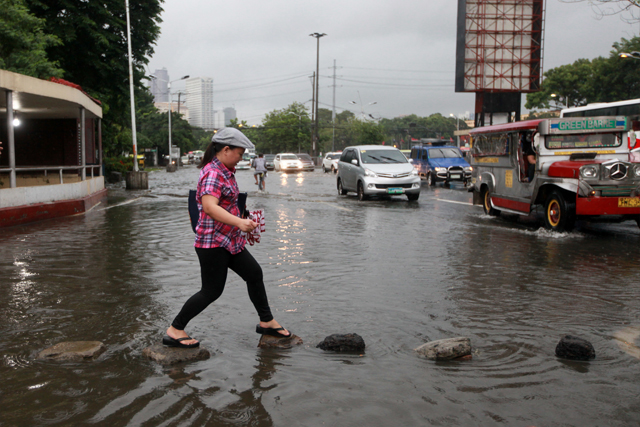La Niña develops; expect rains, flooding

There is a 70 percent chance that La Niña will hit the country next month until the first quarter of 2018, Ana Liza Solis, officer-in-charge of the Philippine Atmospheric, Geophysical and Astronomical Services Administration climate monitoring and prediction section, said, citing forecasts gathered from international climate prediction centers. AP/Bullit Marquez, File
MANILA, Philippines — Brace for more rains and possible flooding in the coming months due to a developing weak La Niña, the state weather bureau advised the public yesterday.
There is a 70 percent chance that La Niña will hit the country next month until the first quarter of 2018, Ana Liza Solis, officer-in-charge of the Philippine Atmospheric, Geophysical and Astronomical Services Administration (PAGASA)’s climate monitoring and prediction section, said, citing forecasts gathered from international climate prediction centers.
La Niña is the abnormal cooling of the eastern section of the Pacific Ocean. The phenomenon brings more than the usual amount of rainfall, particularly in Southeast Asia, Africa and Brazil.
Solis said near to above normal rainfall will likely be experienced across the country starting next month until December.
By January next year, low to lower than normal rainfall can be expected over Luzon and above normal rains in most parts of the Visayas and Mindanao.
Near normal rainfall is expected in Luzon with patches of below normal rainfall over the Ilocos region in February.
Below normal rain will prevail in March in most parts of Luzon, except in Aurora and Isabela as well as in the Bicol region, which will have near normal rain. Mindanao and the Visayas are likely to experience near to above normal rainfall.
In April, below normal rain will be experienced in most parts of Luzon, except in Aurora and Southern Tagalog, which will have near normal rainfall. The rest of the country will likely experience near to above normal rainfall.
La Niña brought severe flooding in parts of Mindanao in January.
PAGASA said back-to-back La Niña is not unusual and has occurred at least five times since 1950.
The most recent La Niña occurred from 2010 to 2012.
The country experienced massive flooding due to days of intense rains spawned by the southwest monsoon in 2012.
Meanwhile, Solis said up to five tropical cyclones are expected to enter the Philippine area of responsibility from November to April next year.
As Typhoon Pablo exited the country on Sunday, another low-pressure area was monitored over the Pacific Ocean.
- Latest
- Trending


























